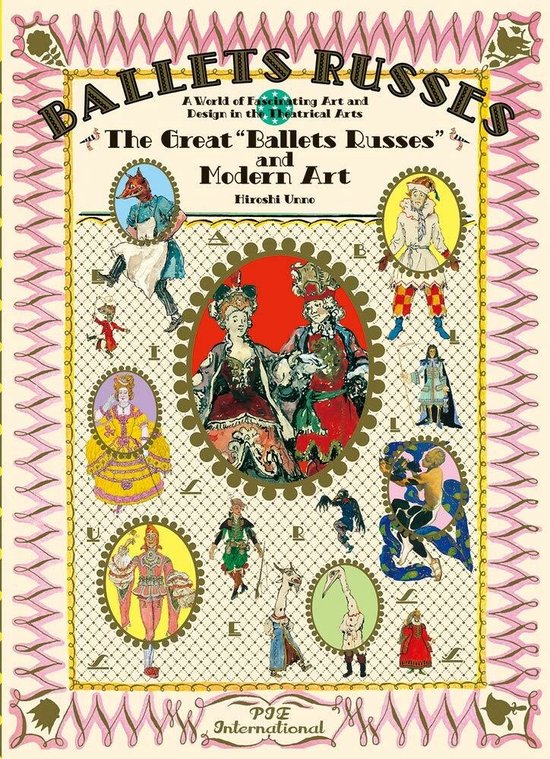Anyone wishing to understand the full splendor and origins of ballet design — costumes and stage settings — will want Mary Clarke and Clement Crisp's comprehensive history and wide-ranging survey, which begins with the Renaissance spectacle itself. As carly as the Aifteenth century, claborate court entertainments were performed to celebrate important events —a dynastie marriage, a political alliance, a war successfully completed — which were remarkable manifestations ranging from processions and masquerades to dinner ballets and ballets de cour. All were part of the glory that surrounded the reigning monarch and his family.
Through the 300 superb illustrations, including 35 in full color, we see a detailed perspective of design — from the early court spectacles through the neoclassic and romantic periods to the revolutionary ideas of Diaghilev's Ballets Russes. Traditionally, with its wide scope for display and effect, ballet has given designers the opportunity to experiment and impress. Its history has seen spectacles of ascending and descending clouds and chariots, storms and shipwrecks, and visions of ethereal cities glimpsed through pillared colonnades, while forests of dangling ropes, multi-colored film projections, and kaleidoscopic optical effects are a few of the features of the art today.
Through comparisons of stage and social dress, and of architecture and stage settings of the periods, we learn how ballet theatrical productions developed. From the Inigo Jones-Ben Jonson collaboration of the Stuart period through such later designers as Alexandre Benois, Léon Bakst, Eugene Berman, and Nicholas Georgiadis, we see how ballet design began to develop freely as an art form.
The authors have provided a study in great depth òf ballet design in this century, concentrating especially on works staged during the past forty years. The almost limirless scope in ballet for original and even abstract decoration has attracted artists of the caliber and standing of Picasso, Matisse, Léger, Chagall, Dali, Vasarely, Noguchi, Rauschenberg, and Warhol. Within this scope there is a vast range of variety — from the classicism of Soviet ballets, to the startling sets, lighting, and costumes of some contemporary American companies. Design for Ballet is destined to become an essential volume of information for all regional ballet companies, local schools, for teacher and students alike.
Both authors are eminent writers on dance. Together they have written Ballet: An Illustrated History, Making a Ballet, and Understanding Ballet. MARY CLARKE is editor of Dancing Tires, writes on dance for the London Guardian, and has just published a monumental Encyclopedia of Dance and Ballet. CLEMENT CRISP, librarian and tutor at the Royal Academy of Dancing, is ballet critic of the London Financial Times and is coauthor of Ballet for All with Peter Brinson. In selecting the examples of design for the ballet which are included ín this book we have been guided by a desire to give as representative a selection as lay within our power. But it would be entirely unrealistic to suppose that we could do more than skim the surface of the vast treasury of material which is to be found in many collections both public and private. Some reflection of the vagaries of stage design as an art form will be found in the representative weighting of different periods, and this in itsclf we hope may be found significant. Certain eras in the past are more generally known than others as far as ballet design is concerned: we have endeavoured to do justice to these without stressing material already overfamiliar to the public. In the case of the Diaghilev years — that golden age for the decoration of ballet — we have eschewed much of what may be found in the several admirable books about the Diaghilev enterprise. For more recent periods and for the ballet of our day we must note that serious problems exist for anyone rescarching design. Certain companies, and indeed certain nations, have been unable to furnish the kind of material that was requested or that would reproduce — and we must here stress a most important point: choice of illustrations has been inevitably guided by the suitability of the design for reproduction on the printed page. Furthermore, there is an evanescence in much contemporary design. Many modern dance companies, in particular, decorate works in an impromptu fashion, or are impelled by financial stringency into arbitrary or severely restricted decorative ways. A few important designers are not represented properly either because their work is so delicate that it has not been caught by the camera — Sophie Fedorovitch a case in point — or because it relies upon particular qualities of fabric and light which exist only in the theatre. Occasionally the work of a major designer is not adequately preserved and we must note the rather curious fact that we have been unable to discover a truly representative photograph of Noguchi’s superlative setting for Seraphic Dialogue.






